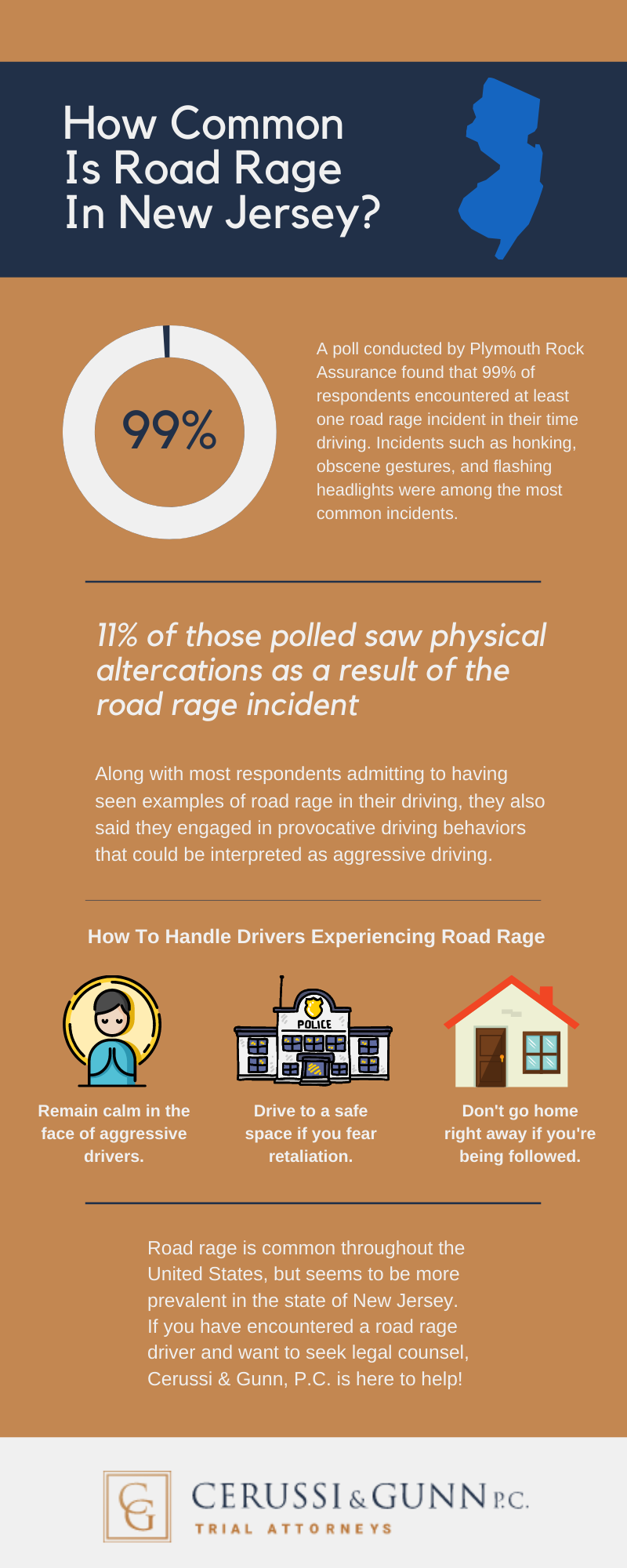Road rage is a dangerous problem that contributes to hundreds of car accidents and physical assaults each year. It can happen when a driver lets their frustration grow to the point of affecting their ability to drive. Road rage can lead to dangerous acts such as speeding, weaving between lanes, and tailgating. It could also motivate a driver to commit crimes such as assault or stalking.
As a driver in New Jersey, learn your odds of encountering a road rage driver and prepare yourself in case of an altercation. If you’ve been in a car crash in New Jersey, don’t hesitate to contact our Monmouth County car accident lawyers for a free case consultation.
Road rage occurs in virtually every state in the United States. It can happen on a rural or urban road any time a driver does not deal with strong emotions in a healthy and safe way behind the wheel. A driver experiencing anger or frustration at the conditions of the road, a neighboring driver, or an unrelated issue could affect how a person drives. This could lead to serious auto accidents or disputes.
Road rage remains a common occurrence in New Jersey, according to a survey by Plymouth Rock Assurance. The Road Rage Survey asked 1,012 drivers with valid licenses in New Jersey about their experiences with road rage drivers. It found that 99% of respondents had encountered at least one road rage incident. The most common road rage incidents listed were honking, rude and obscene gestures, swearing/cursing, and flashing headlights. Eleven percent (11%) of those surveyed had witnessed physical altercations due to road rage.

Survey respondents also listed provocative driving behaviors they’d witnessed, including changing lanes without signaling, driving through yellow lights, tailgating, hovering in the passing lane and ignoring rights-of-way. Almost all respondents (96%) admitted to engaging in provocative driving behaviors themselves. The percentages of drivers in New Jersey who reported experiencing occasional uncontrollable anger were 28% for females and 30% for males. According to respondents, the most aggressive time to be on the road is the morning rush hour (6:00 a.m. to 9:00 a.m.).
Many drivers do not like to admit they have engaged in road rage and aggressive driving behaviors. The actual percentages of people who have felt the phenomena in New Jersey could be much higher than the survey indicated – especially since almost 100% of people polled said they’d witnessed road rage in the state before. Your odds of encountering a road rage driver could be relatively high in New Jersey compared to other states, so it may be wise to prepare yourself to respond safely and appropriately if you do come across an aggressive driver on your commute.
Drivers in the Garden State have options at their disposal to help deal with drivers experiencing road rage while out driving. Instead of returning any rude gestures you may have received, remaining calm and properly assessing the situation can help determine the appropriate response.
Having the ability to differentiate between aggressive driving and road rage is critical when handling this situation. While both scenarios can prove dangerous, road range describes intentional actions meant to harm you, such as ramming your vehicle or running you off the road. A road rage driver could also exit the vehicle and use a weapon, such as a firearm, to try to hurt you.
If you think you are dealing with a road rage driver, call 911 and give the police the driver’s license plate number right away. Do not make eye contact with the driver as you react. Try to create as much room as possible between you and the other driver while keeping those around you safe.
The next step involves getting to a safe place. Try to drive to a safe, well-lit area to pull over your vehicle. If the angry driver is following you, go directly to the nearest police station. Do not let the road rage driver’s anger determine your reaction. Try to stay calm and do not give the driver more of a reason to threaten or harass you through escalating retaliation. Refrain from using strong language or hand gestures back to an aggressive or road-rage driver. Instead, stay inside your vehicle with the windows safely rolled up until the police arrive or the driver leaves.
Ignoring the other driver and not letting them elicit a response from you could prevent the situation from escalating into a disaster.
Finally — and this might be the most important step to remember — do not go straight home. You never know when a person experiencing this much rage and aggression could do things outside of their typical character and follow you home and potentially cause you and your family harm.
If you find yourself in a position where you are a victim of road rage, a car accident law firm can help you receive your compensation. Contact our car and truck accident lawyers today for a free consultation.